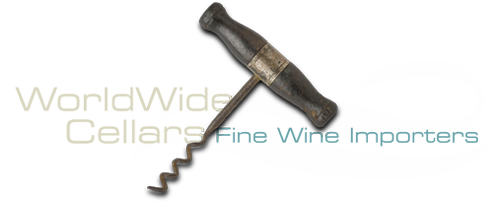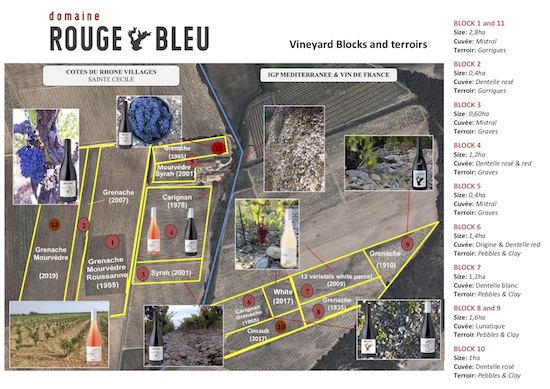Domaine Rouge-Bleu

Domaine Rouge-Bleu was founded in 2007 by Jean-Marc Espinasse, a creative dreamer whose roots in the wine industry have touched both a continuing brokering business, and much hands-on work with his uncle, Monsieur Jean-Claude Vidal, who along with his family, gives life to the wonderful Domaine du Banneret in Châteauneuf-du-Pape.
In 2012, life partners Caroline Jones and Thomas Bertrand purchased the Domaine. Caroline is a trained enologist from Western Australia, who's MO is "...to harmonize the modern methods taught in Australia with the traditions and styles of France." Her partner Thomas was born near Alsace in the Vosges mountains. He spent 12 years in the UK working exclusively in the wine trade. After working for one of the major wine estates in Chateauneuf-du-Pape as head of Domestic Sales and Oenotourism, he was able, since 2015, to devote himself fully to Domaine Rouge-Bleu.
Domaine Rouge-Bleu was and still is tiny … 8.5 hectares of stone and vine, producing minuscule yields. The work is hard but satisfying. In addition to doing virtually all of the farming themselves, the couple runs a Bed and Breakfast on the property, and raise two young daughters. The biggest project currently is the replanting of many of the vineyard parcels, and, being organic and biodynamic, finding strategies to keep the competition from weeds, flowers, herbs and grass from overtaking the vineyards each summer. The hope is to soon achieve yields closer to 25 or 30 hl/ha through improved vineyard management. As of February 2020, they had just completed planted a final 1ha that they had previously ripped out.
Recently their village of Sainte-Cécile les Vignes was elevated as one of fewer than 20 Côtes du Rhone Villages allowed to conjoin the village name - Côtes du Rhone Sainte-Cécile. This gives their appellation new prestige, placing Ste Cécile in the company of Cairanne, Sablet, Chusclan, Séguret, and others.
Thomas and Caroline are some of the hardest working vignerons on the planet, and indeed two of the nicest people in all of France. Their journey is barely begun - they are truly part of the new guard of modern French winegrowers who deeply understand wine's place in the world today, along with ecological sustainability and an innate feel for the idea of terroir. It is a privilege to work with them.
The 2019 Rosé, tasted on a recent trip to France, is very successful. The cepage this vintage is a bit different, thanks to some Cinsault they were able to source from the next-door neighbors vineyard. In fact, the final assemblage was about 30% Carignan, 30% Cinsault, 15% Grenache and 15% Syrah, plus a wee bit of Clairette-Rosé (one of Chateauneuf’s grapes) as well as an intriguing ancestor of Cinsault called Aramont. Fermented and raised in lined concrete. About 8000 bottles produced.
Lunatique has a new trick up its sleeve as well. The 100% Very Old Vine Grenache from the single “Lunatique” vineyard spent time fermenting with the lees of the domaine’s vin blanc (14 varietals), which gave the wine tremendous lift and aromatic interest.
As always, farming is organic, using biodynamic treatments and method, and nothing is added to the wines natural ferment. Fermentations begin spontaneously, there is no de-stemming of fruit for the red wines, and fermentation in all cases but the rosé is executed in porous, unlined concrete.
Thomas and Caroline are doing some of the most exciting work in the southern Rhone…and the wines show it.


